|
Carrier Air Group 2
(CVG-2) August 16, 1958
in 1/72 Scale
By Joe Lyons
|
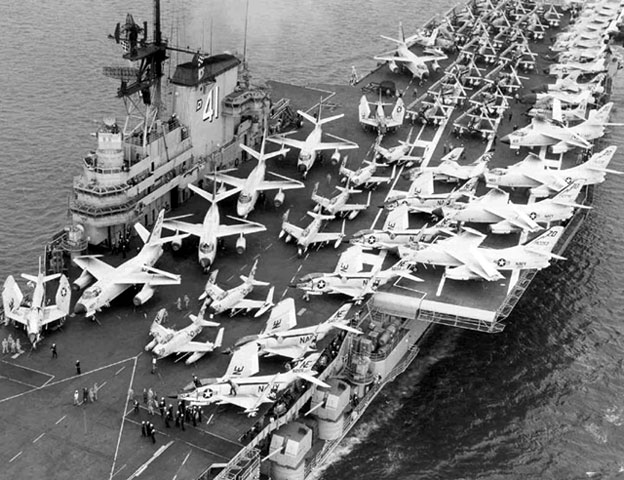
|
|
Carrier Air Group 2 (CVG-2)
headed for Japan
USS Midway (CV-41), San Francisco, 5:00pm August 16, 1958
Photo Copyright © 1958
by William Larkins
|

available online from
Squadron.com
This project is a snapshot in time of a mid-‘50s
USN carrier air group (before they became wings). I’ve done a number of
carrier air groups (e.g., one representative of every type in the
group), but never one with this many different aircraft.
The inspiration was a William Larkins photo
(reference d and the title photo) taken from a San Francisco bridge on
August 16, 1958 looking down on the flight deck of USS Midway (CV-41)
as it departs for a Western Pacific Deployment.

CVG-2 Composition
“NE” air group code- reference b (see reference list at the bottom of
the page)
VF-211:
F8U-1 Crusader
VF-84:
F3H-2M Demon
VA-63:
FJ-4B Fury
VAH-8:
A3D-2N Skywarrior
VA-65:
AD-6 Skyraider
VAAW-35: AD-5N Skyraider
VAW-11: AD-5W Skyraider
VAW-11: AD-5Q Skyraider
VFP-61:
F8U-1P Crusader
HU-1:
HUP-2 Retriever
The Carrier Air Group (Wing)
The organization of aviation assets on carriers has
always represented in one respect, the least efficient way of doing this
sort of business. The USAF would call an air group a “composite” wing,
and such organizations were for generations anathema to the Air Force.
Worse, the air group in addition to being composed of many different
types of aircraft with disparate functions, also did composite and
composite-type squadrons within the group. In CVG-2, the most visible
example of the latter is VA-63, an attack organization stocked with
fighters with three separate missions: nuclear weapons delivery,
conventional attack, and fighter. VAW-11 brought two varieties of Spad
for electronic warfare.
All of the functions in CVG-2 can be found in a 21st
century air group, minus strategic nuclear attack and plus ASW, but with
far fewer air craft types; eventually, CVG-2’s many different aircraft
types would become unsupportable. In “the photo” are represented
about 160 20mm cannon of at least two varieties, three different jet
engines in four versions, one recip engine and six different airborne
radars. Pity the CAG maintenance officer.
Nuclear War Fighting
CVG-2 on this date is a representative attack
carrier force of the time, particularly the heavy emphasis on nuclear
weapons delivery. Two squadrons (VAH-8 and VA-63) have this mission as a
primary task, in Heavy Eight’s case, its only task. The AD squadron and
the night attack detachment also practice nuclear weapons delivery. One
source (reference i) states about 60% of an attack squadron’s resources
at the time were dedicated to the nuke stuff. Gull gray and anti-nuke
flash white are the obvious manifestations of this preoccupation in the
USN.
The mid-‘50s CV air group had evolved in type functionality very little
since the post-war air group had coalesced in the period 1945-1950. The
basic fighter and attack squadrons were supported and supplemented by
various special mission detachments. The latter included photo recce,
night attack, early warning, electronic warfare, and helicopter SAR. One
significant change from a Korean War air group was the presence of a
full squadron of fighters dedicated to all weather/night fighting
(VF-84) with the first AAMs in USN service. The squadron had evolved
from the four aircraft night fighter detachments present on US carriers
since mid-WW II.
The Aircraft of
CVG-2 on August 14, 1958
|
The Fighters
The day fighter is the F8U-1 Crusader,
undoubtedly the best day fighter on the planet at that time. It was
equipped with four guns and two ‘winders.
The night fighter is the F3H-2M Demon with a
working CW radar for the Sparrow, two guns and also Sidewinder capable.
However, the Demon was no world-beater.
The THIRD fighter type is the FJ-4B Fury,
called by some (Marion Carl among others) the best non-afterburning
fighter that would ever be built anywhere. In CVG-2, the Furies equipped
a VA squadron. Fighters in VA were a dead giveaway at the time for a
nuclear delivery mission. Four guns, sidewinder capable, and equipped on
Midway with some of the first buddy stores. You never see
Crusaders carrying external gas, and the Demon and Fury seldom. The Fury
carried 840 US gal of internal fuel, about as much as two Hunter F.4 s
{references g and h).
The Demon carried over 1800 gal and the Crusader
about 1000 gal. Designed with a huge internal tankage for blue water ops
before air-to-air fueling was common, they could get by without it.
The Bombers
The Big Stick on Midway was the
A3D-2N, designed to bring a serious nuclear delivery to carriers. AD-6s
and AD-5Ns filled out the rest of the bomber community. Plus those
Furies.
Ironically, the great effort to get
the Skywarrior capable of lifting the big late-1940s Bomb onto carrier
decks was overcome by events. The faster air-refuelable FJ-4B carrying
an about as powerful but smaller weapon would prove to be the better
delivery system.
Special Mission
The SAR helo, although not in the photo, would have been the HUP-2
Retriever. The AD family was well represented past the straight bombers;
the AD-5W and AD-5Q did the electronic work. All of the types mentioned
so far are present in the photo, or can inferred to be so (in the case
of the Queer Spad) because there was no other competitor in that role
afloat at the time. I’m making an educated guess (reference f) that the
recce bird was the F8U-1P on what was probably one of its first
deployments. If I guess wrong, it would have been the F9F-8P.
F3H-2M
This is the Emhar kit, built straight from the box. This kit, in
addition to “the photo,” is the other inspiration for this project. The
VF-84 kit decals include the only squadron badge painted on an airplane
in the air group, so I didn’t have to try to duplicate it. Model Master
Flat Gull Gray (FS 36440) and someone’s gloss white, both used
throughout the project, except for the helo. References c, d and e.
Note the “NE” air group code letters. Yellow trim for the second
squadron.

F8U-1
This is the Hasegawa F8E kit, backdated to the –1.
No ventral fins or afterburner cooling (easy), Esoteric nose for the kit
nose (pretty easy), and removal of the Bullpup hump (tedious). Two vice
four missiles. Closed canopy and wings unfolded (as are the rest of the
air group models). VF-211 (references c and d), with the “NE” codes.
“105” from the references. Red trim on the fuselage for the first
squadron and fin checkerboard masked to fit. Various numbers filled out
from various decal sheets.
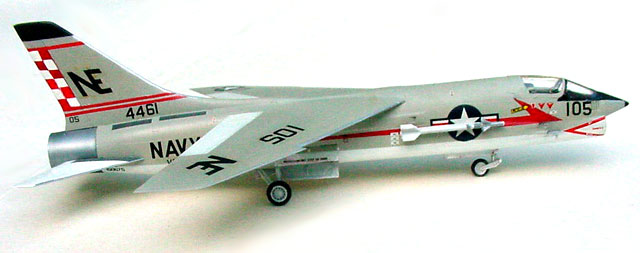
FJ-4B
This is the Emhar kit, built straight from the box.
VA-63 markings (references c, d and g) filled out from various decal
sheets. Blue trim as befits the third squadron done with lots of masking
tape and airbrush.

A3D-2N
Hasegawa kit of the “early version” Whale, with
resin nose and tail. Basically OOB except for squadron markings. VAH-8
is an exception to the marking rules. Numbered in the 4XX series with
International Orange trim as for the fourth squadron, Heavy Eight
nonetheless retains its unique “ZD” squadron code. References b and d.
Squadron code, orange lightning bolt, serial and “404” decals done via a
color laser printer.

AD-6
Airfix kit, OOB. Fifth squadron, 507, green trim
and “NE” all homegrown or cobbled
from other decal sheets. AD’s are in the “photo,”
but no specific markings visible. Markings taken from photo of VA-65
aircraft in reference a. In Vietnam, the Spad was known as a “two box
lunch” airplane when on RESCAP, so no refueling probes were necessary on
any ADs in CVG -2.
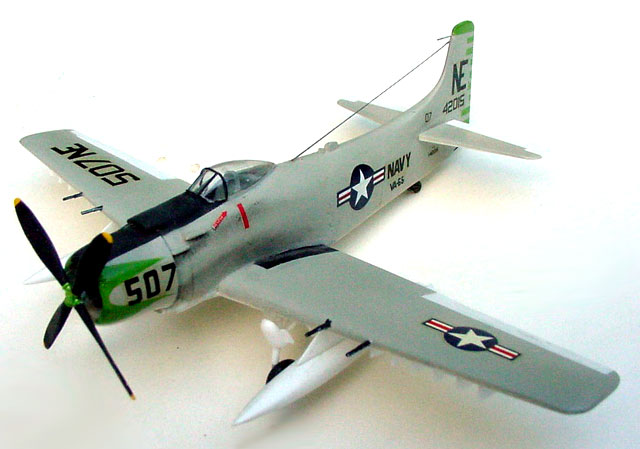
AD-5N
Monogram A-1E kit, OOB with scratch-built
searchlight and APS-31 radar, the latter from an ARII Corsair centerline
drop tank. Drawings used in doing this radar from reference j. I took
the marking specifics from a photo in reference c, again using various
decal sheets. Maroon trim and 8XX numbers. VAAW-35 “VV” squadron code
from an aircraft tucked in among the ‘Saders, in the “photo.”
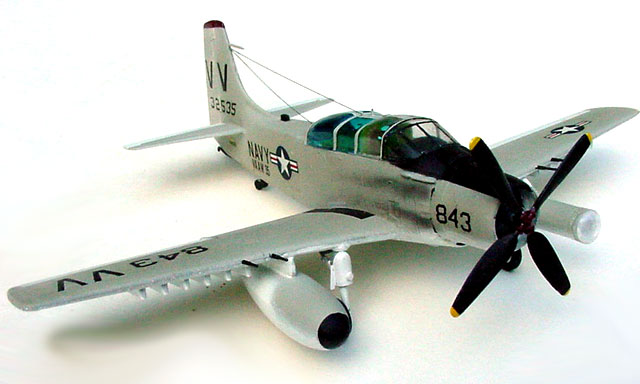
AD-5W
Monogram A-1E kit, as converted using
Falcon radome and solid rear canopy, plus aftermarket engine and
cockpit. Vacu-formed forward canopy, opened up. Maroon trim and 7X
numbers. VAW-11, “RR.” In the “photo,” but no specific markings visible.
Markings are generic for a squadron aircraft from this Pac Fleet warning
squadron. Reference c.
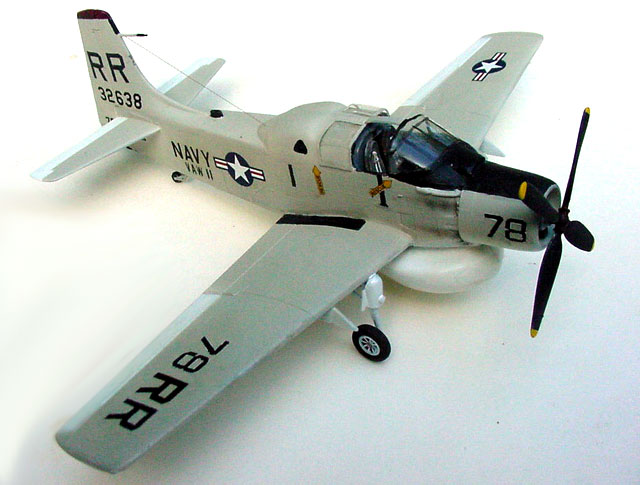
AD-5Q
Monogram A-1E kit, converted using a
vacu-form copy of the Falcon vacu-form solid rear canopy. All but one
outer wing station removed. Added APS-31 radar, drop tank, and outer
wing jamming pods. VAW-11, “RR,” maroon trim and 7X numbers. Markings
are generic; VAW-11 also owned the Queer Spads at the time. Reference c.
Not identifiable in the “photo.”
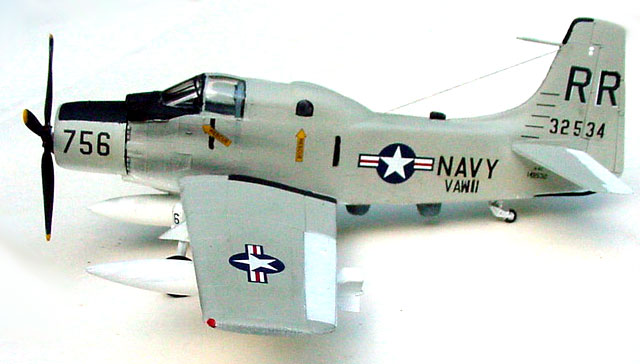
F8U-1P
This is the Hasegawa F8E married to
Falcon RF-8G fuselage and upper center wing section. The –G works for a
–1P conversion if the other items are omitted as for the straight
fighter. The hardest “build” of the lot. Much puttying up of the Falcon
parts, the kit nose and canopy and the kit nose wheel well. Not in
“photo,” but may be in the F8U lineup on the port deck edge. Markings
are generic for squadron (VFP-61). Should have maroon trim, but photos
of contemporary VFP-61 aircraft don’t really show it. However, captions
say the rudder is red. References c and f.
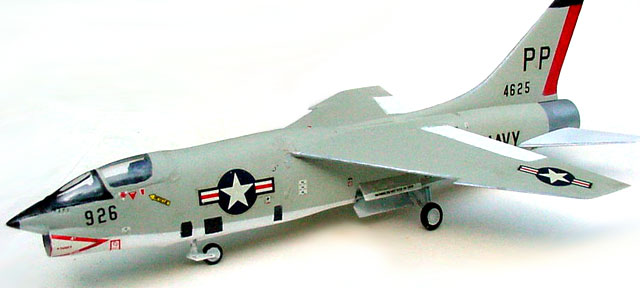
HUP-2
This is the Mach 2 kit (motto: “No
better than we have to be”). Only non-grey/white aircraft. Not visible
in photo; marking are generic for HU-1, the Pac Fleet squadron that
provided the helo dets. SAR helo color had changed by directive to
overall Engine Gray some months prior to the “photo”, so this helo was
done accordingly. I confess to not ever having seen a photo of a HUP-mobile
so painted. Call it artistic license. References b and c.
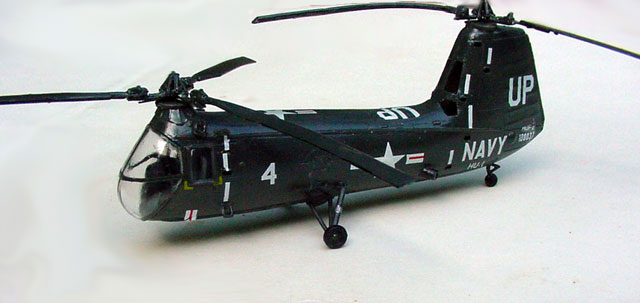
Acknolwedegements and References
|
Special thanks to Richard Tucker, who supplied some marvelous Douglas
drawings of the AN/APS-31 radar pod and its mountings on the AD-5N and
AD-5Q. Yes, they were different, although not by much.
Thanks also to William Larkins for the
kind permission to use his photograph.
References
a.
Doll, T.E., Jackson. B.R., Riley, W.A. (1985). Navy Air Colors.
United States Navy, Marine and Coast Guard Aircraft Camouflage and
Markings Vol. 2 2945-1985. Carrollton, TX: Squadron/Signal
Publications, Inc.
b.
Elliott, H.M. (1991). The Official Monogram US Navy & Marine
Corps Aircraft Color Guide Vol 3 1950-1959. Sturbridge, MA: Monogram
Aviation Publications
c.
Kasulka, D.A. (1985). USN Aircraft Carrier Air Units Volume 2
1957-1963. Carrollton, TX: Squadron/Signal Publications, Inc.
d.
Lawson, R.L. (ed.). (1985). The History of US Naval Air
Power. New York: The Military Press. [“The photo” is on p. 140]
e.
Ginter, S. (1985). Naval Fighters Number Twelve McDonnell F3H
Demon. Simi Valley, CA: Naval Fighters.
f.
Ginter, S. (1988). Naval Fighters Number Seventeen Vought’s
F-8 Crusader Part Two Navy and Marine RF-8 Photo-Recon Squadrons.
Simi Valley, CA: Naval Fighters.
g.
Ginter, S. (1994). Naval Fighters Number Twenty-Five North
American FJ-4/4B Fury. Simi Valley, CA: Naval Fighters.
h.
Mason, F.K. (1992). The British Fighter Since 1912.
Annapolis, MD: Naval Institute Press.
i.
Miller, J. (2001). Nuclear Weapons and Aircraft Carriers.
Washington: Smithsonian Institution Press.
j.
Richard Tucker (personal communication, August 8, 2002) –
AN/APS-31 and the AD-5: Douglas Aircraft Drawings.
Model, Images and Text Copyright © 2002 by
Joe Lyons
Except Title Image Copyright © 1958 by William Larkins
Page Created 24 October, 2002
Last Updated 04 June, 2007
Back to HyperScale
Main Page
Back to
Features Index
|
Home
| What's New |
Features |
Gallery |
Reviews |
Reference |
Forum |
Search